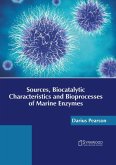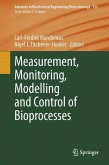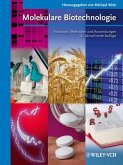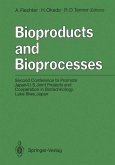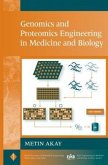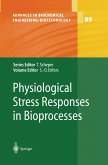Automatic Control of Bioprocesses
Herausgeber: Dochain, Denis
Automatic Control of Bioprocesses
Herausgeber: Dochain, Denis
- Gebundenes Buch
- Merkliste
- Auf die Merkliste
- Bewerten Bewerten
- Teilen
- Produkt teilen
- Produkterinnerung
- Produkterinnerung
Giving an overview of the challenges in the control of bioprocesses, this comprehensive book presents key results in various fields, including: dynamic modeling; dynamic properties of bioprocess models; software sensors designed for the on-line estimation of parameters and state variables; control and supervision of bioprocesses.
Andere Kunden interessierten sich auch für
![Measurement, Monitoring, Modelling and Control of Bioprocesses Measurement, Monitoring, Modelling and Control of Bioprocesses]() Measurement, Monitoring, Modelling and Control of Bioprocesses223,99 €
Measurement, Monitoring, Modelling and Control of Bioprocesses223,99 €![Sources, Biocatalytic Characteristics and Bioprocesses of Marine Enzymes Sources, Biocatalytic Characteristics and Bioprocesses of Marine Enzymes]() Sources, Biocatalytic Characteristics and Bioprocesses of Marine Enzymes131,99 €
Sources, Biocatalytic Characteristics and Bioprocesses of Marine Enzymes131,99 €![Measurement, Monitoring, Modelling and Control of Bioprocesses Measurement, Monitoring, Modelling and Control of Bioprocesses]() Measurement, Monitoring, Modelling and Control of Bioprocesses223,99 €
Measurement, Monitoring, Modelling and Control of Bioprocesses223,99 €![Molekulare Biotechnologie Molekulare Biotechnologie]() Molekulare Biotechnologie87,90 €
Molekulare Biotechnologie87,90 €![Bioproducts and Bioprocesses Bioproducts and Bioprocesses]() Bioproducts and Bioprocesses75,99 €
Bioproducts and Bioprocesses75,99 €![Genomics and Proteomics Engineering in Medicine and Biology Genomics and Proteomics Engineering in Medicine and Biology]() Metin Akay (ed.)Genomics and Proteomics Engineering in Medicine and Biology160,99 €
Metin Akay (ed.)Genomics and Proteomics Engineering in Medicine and Biology160,99 €![Physiological Stress Responses in Bioprocesses Physiological Stress Responses in Bioprocesses]() Physiological Stress Responses in Bioprocesses229,99 €
Physiological Stress Responses in Bioprocesses229,99 €-
-
-
Giving an overview of the challenges in the control of bioprocesses, this comprehensive book presents key results in various fields, including: dynamic modeling; dynamic properties of bioprocess models; software sensors designed for the on-line estimation of parameters and state variables; control and supervision of bioprocesses.
Produktdetails
- Produktdetails
- Verlag: Wiley
- Seitenzahl: 248
- Erscheinungstermin: 1. August 2008
- Englisch
- Abmessung: 240mm x 161mm x 18mm
- Gewicht: 536g
- ISBN-13: 9781848210257
- ISBN-10: 1848210256
- Artikelnr.: 26381657
- Herstellerkennzeichnung
- Libri GmbH
- Europaallee 1
- 36244 Bad Hersfeld
- gpsr@libri.de
- Verlag: Wiley
- Seitenzahl: 248
- Erscheinungstermin: 1. August 2008
- Englisch
- Abmessung: 240mm x 161mm x 18mm
- Gewicht: 536g
- ISBN-13: 9781848210257
- ISBN-10: 1848210256
- Artikelnr.: 26381657
- Herstellerkennzeichnung
- Libri GmbH
- Europaallee 1
- 36244 Bad Hersfeld
- gpsr@libri.de
Denis Dochain is a Professor at the CESAME (Centre for Systems Engineering and Applied Mechanics) of the Université Catholique de Louvain and Honorary Research Director of the FNRS (Fonds National de la Recherche Scientifique, National Fund for Scientific Research), France. He is associate editor of Automatica, the IEEE Transactions on Automatic Control and the Journal of Process Control.
Chapter 1. What are the Challenges for the Control of Bioprocesses? 11
Denis DOCHAIN
1.1. Introduction . 11
1.2. Specific problems of bioprocess control 12
1.3. A schematic view of monitoring and control of a bioprocess 12
1.4. Modeling and identification of bioprocesses: some key ideas 13
1.5. Software sensors: tools for bioprocess monitoring 14
1.6. Bioprocess control: basic concepts and advanced control15
1.7. Bioprocess monitoring: the central issue 15
1.8. Conclusions 16
1.9. Bibliography 16
Chapter 2. Dynamic Models of Biochemical Processes: Properties of Models 17
Olivier BERNARD and Isabelle QUEINNEC
2.1. Introduction 17
2.2. Description of biochemical processes 18
2.2.1. Micro-organisms and their use 18
2.2.2. Types of bioreactors 19
2.2.3. Three operating modes 19
2.3. Mass balance modeling 21
2.3.1. Introduction 21
2.3.2. Reaction scheme 21
2.3.3. Choice of reactions and variables 23
2.3.4. Example 1 23
2.4. Mass balance models 24
2.4.1. Introduction 24
2.4.2. Example 2 24
2.4.3. Example 3 25
2.4.4. Matrix representation 25
2.4.4.1. Example 2 (continuation) 26
2.4.4.2. Example 1 (continuation) 26
2.4.5. Gaseous flow 27
2.4.6. Electroneutrality and affinity constants 27
2.4.7. Example 1 (continuation) 28
2.4.8. Conclusion 29
2.5. Kinetics 30
2.5.1. Introduction 30
2.5.2. Mathematical constraints 30
2.5.2.1. Positivity of variables 30
2.5.2.2. Variables necessary for the reaction 31
2.5.2.3. Example 1 (continuation) 31
2.5.2.4. Phenomenological knowledge 31
2.5.3. Specific growth rate 32
2.5.4. Representation of kinetics by means of a neural network 34
2.6. Validation of the model 35
2.6.1. Introduction 35
2.6.2. Validation of the reaction scheme 35
2.6.2.1. Mathematical principle 35
2.6.2.2. Example 4 36
2.6.3. Qualitative validation of model 37
2.6.4. Global validation of the model 39
2.7. Properties of the models 39
2.7.1. Boundedness and positivity of variables 39
2.7.2. Equilibrium points and local behavior 40
2.7.2.1. Introduction 40
2.8. Conclusion 42
2.9. Bibliography 43
Chapter 3. Identification of Bioprocess Models 47
Denis DOCHAIN and Peter VANROLLEGHEM
3.1. Introduction 47
3.2. Structural identifiability 48
3.2.1. Development in Taylor series 49
3.2.2. Generating series 50
3.2.3. Examples for the application of the methods of development in series
50
3.2.4. Some observations on the methods for testing structural
identifiability 51
3.3. Practical identifiability 52
3.3.1. Theoretical framework 52
3.3.2. Confidence interval of the estimated parameters 54
3.3.3. Sensitivity functions 55
3.4. Optimum experiment design for parameter estimation (OED/PE) 57
3.4.1. Introduction 57
3.4.2. Theoretical basis for the OED/PE 59
3.4.3. Examples 61
3.5. Estimation algorithms 63
3.5.1. Choice of two datasets 63
3.5.2. Elements of parameter estimation: least squares estimation in the
linear case 64
3.5.3. Overview of the parameter estimation algorithms 65
3.6. A case study: identification of parameters for a process modeled for
anaerobic digestion 68
3.6.1. The model 69
3.6.2. Experiment design 70
3.6.3. Choice of data for calibration and validation 70
3.6.4. Parameter identification 71
3.6.5. Analysis of the results 75
3.7. Bibliography 75
Chapter 4. State Estimation for Bioprocesses 79
Olivier BERNARD and Jean-Luc GOUZÉ
4.1. Introduction 79
4.2. Notions on system observability 80
4.2.1. System observability: definitions 80
4.2.2. General definition of an observer 81
4.2.3. How to manage the uncertainties in the model or in the output 83
4.3. Observers for linear systems 84
4.3.1. Luenberger observer 85
4.3.2. The linear case up to an output injection 86
4.3.3. Local observation of a nonlinear system around an equilibrium point
86
4.3.4. PI observer 87
4.3.5. Kalman filter 87
4.3.6. The extended Kalman filter 89
4.4. High gain observers 89
4.4.1. Definitions, hypotheses 89
4.4.2. Change of variable 90
4.4.3. Fixed gain observer 91
4.4.4. Variable gain observers (Kalman-like observer) 91
4.4.5. Example: growth of micro-algae 92
4.5. Observers for mass balance-based systems 94
4.5.1. Introduction 94
4.5.2. Definitions, hypotheses 96
4.5.3. The asymptotic observer 96
4.5.4. Example 98
4.5.5. Improvements 99
4.6. Interval observers 101
4.6.1. Principle 102
4.6.2. The linear case up to an output injection 103
4.6.3. Interval estimator for an activated sludge process 105
4.6.4. Bundle of observers 107
4.7. Conclusion 110
4.8. Appendix: a comparison theorem 111
4.9. Bibliography 112
Chapter 5. Recursive Parameter Estimation 115
Denis DOCHAIN
5.1. Introduction 115
5.2. Parameter estimation based on the structure of the observer 116
5.2.1. Example: culture of animal cells 116
5.2.2. Estimator based on the structure of the observer 117
5.2.3. Example: culture of animal cells (continued) 119
5.2.4. Calibration of the estimator based on the structure of the observer:
theory 119
5.2.5. Calibration of the estimator based on the structure of the observer:
application to the culture of animal cells 124
5.2.6. Experimental results 127
5.3. Recursive least squares estimator 129
5.4. Adaptive state observer 133
5.4.1. Generalization 138
5.5. Conclusions 140
5.6. Bibliography 141
Chapter 6. Basic Concepts of Bioprocess_Control 143
Denis DOCHAIN and Jérôme HARMAND
6.1. Introduction 143
6.2.1. Biological system dynamics 144
6.2.2. Sources of uncertainties and disturbances of biological systems 146
6.3. Stability of biological processes 147
6.3.1. Basic concept of the stability of a dynamic system 147
6.3.2. Equilibrium point 148
6.3.3. Stability analysis 149
6.4. Basic concepts of biological process control 150
6.4.1. Regulation and tracking control 150
6.4.2. Strategy selection: direct and indirect control 151
6.2. Bioprocess control: basic concepts 144
6.4.3. Selection of synthesis method 152
6.5. Synthesis of biological process control laws 153
6.5.1. Representation of systems 153
6.5.2. Structure of control laws 154
6.6. Advanced control laws 160
6.6.1. A nonlinear PI controller 160
6.6.2. Robust control 162
6.7. Specific approaches 165
6.7.1. Pulse control: a dialog with bacteria 165
6.7.2. Overall process optimization: towards integrating the control
objectives in the initial stage of bioprocess design 167
6.8. Conclusions and perspectives 170
6.9. Bibliography 170
Chapter 7. Adaptive Linearizing Control and Extremum-Seeking Control of
Bioprocesses 173
Denis DOCHAIN, Martin GUAY, Michel PERRIER and Mariana TITICA
7.1. Introduction 173
7.2. Adaptive linearizing control of bioprocesses 174
7.2.1. Design of the adaptive linearizing controller 174
7.2.2. Example 1: anaerobic digestion 176
7.2.2.1. Model order reduction 177
7.2.2.2. Adaptive linearizing control design 179
7.2.3. Example 2: activated sludge process 183
7.3. Adaptive extremum-seeking control of bioprocesses 188
7.3.1. Fed-batch reactor model 189
7.3.2. Estimation and controller design 191
7.3.2.1. Estimation equation for the gaseous outflow rate y 191
7.3.2.2. Design of the adaptive extremum-seeking controller 192
7.3.2.3. Stability and convergence analysis 195
7.3.2.4. A note on dither signal design 196
7.3.3. Simulation results 197
7.4. Appendix: analysis of the parameter convergence 202
7.5. Bibliography 207
Chapter 8. Tools for Fault Detection and Diagnosis 211
Jean-Philippe STEYER, Antoine GÉNOVÉSI and Jérôme HARMAND
8.1. Introduction 211
8.2. General definitions 212
8.2.1. Terminology 212
8.2.2. Fault types 213
8.3. Fault detection and diagnosis 214
8.3.1. Methods based directly on signals 215
8.3.1.1. Hardware redundancy 215
8.3.1.2. Specific sensors 216
8.3.1.3. Comparison of thresholds 217
8.3.1.4. Spectral analysis 217
8.3.1.5. Statistical approaches 218
8.3.2. Model-based methods 218
8.3.2.1. Parity space 219
8.3.2.2. Observers 220
8.3.2.3. Parametric estimation 221
8.3.3. Methods based on expertise 222
8.3.3.1. AI models 223
8.3.3.2. Artificial neural networks 224
8.3.3.3. Fuzzy inference systems 225
8.3.4. Choice and combined use of diverse methods 227
8.4. Application to biological processes 227
8.4.1. "Simple" biological processes 228
8.4.2. Wastewater treatment processes 229
8.5. Conclusion 231
8.6. Bibliography 232
List of Authors 239
Index 241
Denis DOCHAIN
1.1. Introduction . 11
1.2. Specific problems of bioprocess control 12
1.3. A schematic view of monitoring and control of a bioprocess 12
1.4. Modeling and identification of bioprocesses: some key ideas 13
1.5. Software sensors: tools for bioprocess monitoring 14
1.6. Bioprocess control: basic concepts and advanced control15
1.7. Bioprocess monitoring: the central issue 15
1.8. Conclusions 16
1.9. Bibliography 16
Chapter 2. Dynamic Models of Biochemical Processes: Properties of Models 17
Olivier BERNARD and Isabelle QUEINNEC
2.1. Introduction 17
2.2. Description of biochemical processes 18
2.2.1. Micro-organisms and their use 18
2.2.2. Types of bioreactors 19
2.2.3. Three operating modes 19
2.3. Mass balance modeling 21
2.3.1. Introduction 21
2.3.2. Reaction scheme 21
2.3.3. Choice of reactions and variables 23
2.3.4. Example 1 23
2.4. Mass balance models 24
2.4.1. Introduction 24
2.4.2. Example 2 24
2.4.3. Example 3 25
2.4.4. Matrix representation 25
2.4.4.1. Example 2 (continuation) 26
2.4.4.2. Example 1 (continuation) 26
2.4.5. Gaseous flow 27
2.4.6. Electroneutrality and affinity constants 27
2.4.7. Example 1 (continuation) 28
2.4.8. Conclusion 29
2.5. Kinetics 30
2.5.1. Introduction 30
2.5.2. Mathematical constraints 30
2.5.2.1. Positivity of variables 30
2.5.2.2. Variables necessary for the reaction 31
2.5.2.3. Example 1 (continuation) 31
2.5.2.4. Phenomenological knowledge 31
2.5.3. Specific growth rate 32
2.5.4. Representation of kinetics by means of a neural network 34
2.6. Validation of the model 35
2.6.1. Introduction 35
2.6.2. Validation of the reaction scheme 35
2.6.2.1. Mathematical principle 35
2.6.2.2. Example 4 36
2.6.3. Qualitative validation of model 37
2.6.4. Global validation of the model 39
2.7. Properties of the models 39
2.7.1. Boundedness and positivity of variables 39
2.7.2. Equilibrium points and local behavior 40
2.7.2.1. Introduction 40
2.8. Conclusion 42
2.9. Bibliography 43
Chapter 3. Identification of Bioprocess Models 47
Denis DOCHAIN and Peter VANROLLEGHEM
3.1. Introduction 47
3.2. Structural identifiability 48
3.2.1. Development in Taylor series 49
3.2.2. Generating series 50
3.2.3. Examples for the application of the methods of development in series
50
3.2.4. Some observations on the methods for testing structural
identifiability 51
3.3. Practical identifiability 52
3.3.1. Theoretical framework 52
3.3.2. Confidence interval of the estimated parameters 54
3.3.3. Sensitivity functions 55
3.4. Optimum experiment design for parameter estimation (OED/PE) 57
3.4.1. Introduction 57
3.4.2. Theoretical basis for the OED/PE 59
3.4.3. Examples 61
3.5. Estimation algorithms 63
3.5.1. Choice of two datasets 63
3.5.2. Elements of parameter estimation: least squares estimation in the
linear case 64
3.5.3. Overview of the parameter estimation algorithms 65
3.6. A case study: identification of parameters for a process modeled for
anaerobic digestion 68
3.6.1. The model 69
3.6.2. Experiment design 70
3.6.3. Choice of data for calibration and validation 70
3.6.4. Parameter identification 71
3.6.5. Analysis of the results 75
3.7. Bibliography 75
Chapter 4. State Estimation for Bioprocesses 79
Olivier BERNARD and Jean-Luc GOUZÉ
4.1. Introduction 79
4.2. Notions on system observability 80
4.2.1. System observability: definitions 80
4.2.2. General definition of an observer 81
4.2.3. How to manage the uncertainties in the model or in the output 83
4.3. Observers for linear systems 84
4.3.1. Luenberger observer 85
4.3.2. The linear case up to an output injection 86
4.3.3. Local observation of a nonlinear system around an equilibrium point
86
4.3.4. PI observer 87
4.3.5. Kalman filter 87
4.3.6. The extended Kalman filter 89
4.4. High gain observers 89
4.4.1. Definitions, hypotheses 89
4.4.2. Change of variable 90
4.4.3. Fixed gain observer 91
4.4.4. Variable gain observers (Kalman-like observer) 91
4.4.5. Example: growth of micro-algae 92
4.5. Observers for mass balance-based systems 94
4.5.1. Introduction 94
4.5.2. Definitions, hypotheses 96
4.5.3. The asymptotic observer 96
4.5.4. Example 98
4.5.5. Improvements 99
4.6. Interval observers 101
4.6.1. Principle 102
4.6.2. The linear case up to an output injection 103
4.6.3. Interval estimator for an activated sludge process 105
4.6.4. Bundle of observers 107
4.7. Conclusion 110
4.8. Appendix: a comparison theorem 111
4.9. Bibliography 112
Chapter 5. Recursive Parameter Estimation 115
Denis DOCHAIN
5.1. Introduction 115
5.2. Parameter estimation based on the structure of the observer 116
5.2.1. Example: culture of animal cells 116
5.2.2. Estimator based on the structure of the observer 117
5.2.3. Example: culture of animal cells (continued) 119
5.2.4. Calibration of the estimator based on the structure of the observer:
theory 119
5.2.5. Calibration of the estimator based on the structure of the observer:
application to the culture of animal cells 124
5.2.6. Experimental results 127
5.3. Recursive least squares estimator 129
5.4. Adaptive state observer 133
5.4.1. Generalization 138
5.5. Conclusions 140
5.6. Bibliography 141
Chapter 6. Basic Concepts of Bioprocess_Control 143
Denis DOCHAIN and Jérôme HARMAND
6.1. Introduction 143
6.2.1. Biological system dynamics 144
6.2.2. Sources of uncertainties and disturbances of biological systems 146
6.3. Stability of biological processes 147
6.3.1. Basic concept of the stability of a dynamic system 147
6.3.2. Equilibrium point 148
6.3.3. Stability analysis 149
6.4. Basic concepts of biological process control 150
6.4.1. Regulation and tracking control 150
6.4.2. Strategy selection: direct and indirect control 151
6.2. Bioprocess control: basic concepts 144
6.4.3. Selection of synthesis method 152
6.5. Synthesis of biological process control laws 153
6.5.1. Representation of systems 153
6.5.2. Structure of control laws 154
6.6. Advanced control laws 160
6.6.1. A nonlinear PI controller 160
6.6.2. Robust control 162
6.7. Specific approaches 165
6.7.1. Pulse control: a dialog with bacteria 165
6.7.2. Overall process optimization: towards integrating the control
objectives in the initial stage of bioprocess design 167
6.8. Conclusions and perspectives 170
6.9. Bibliography 170
Chapter 7. Adaptive Linearizing Control and Extremum-Seeking Control of
Bioprocesses 173
Denis DOCHAIN, Martin GUAY, Michel PERRIER and Mariana TITICA
7.1. Introduction 173
7.2. Adaptive linearizing control of bioprocesses 174
7.2.1. Design of the adaptive linearizing controller 174
7.2.2. Example 1: anaerobic digestion 176
7.2.2.1. Model order reduction 177
7.2.2.2. Adaptive linearizing control design 179
7.2.3. Example 2: activated sludge process 183
7.3. Adaptive extremum-seeking control of bioprocesses 188
7.3.1. Fed-batch reactor model 189
7.3.2. Estimation and controller design 191
7.3.2.1. Estimation equation for the gaseous outflow rate y 191
7.3.2.2. Design of the adaptive extremum-seeking controller 192
7.3.2.3. Stability and convergence analysis 195
7.3.2.4. A note on dither signal design 196
7.3.3. Simulation results 197
7.4. Appendix: analysis of the parameter convergence 202
7.5. Bibliography 207
Chapter 8. Tools for Fault Detection and Diagnosis 211
Jean-Philippe STEYER, Antoine GÉNOVÉSI and Jérôme HARMAND
8.1. Introduction 211
8.2. General definitions 212
8.2.1. Terminology 212
8.2.2. Fault types 213
8.3. Fault detection and diagnosis 214
8.3.1. Methods based directly on signals 215
8.3.1.1. Hardware redundancy 215
8.3.1.2. Specific sensors 216
8.3.1.3. Comparison of thresholds 217
8.3.1.4. Spectral analysis 217
8.3.1.5. Statistical approaches 218
8.3.2. Model-based methods 218
8.3.2.1. Parity space 219
8.3.2.2. Observers 220
8.3.2.3. Parametric estimation 221
8.3.3. Methods based on expertise 222
8.3.3.1. AI models 223
8.3.3.2. Artificial neural networks 224
8.3.3.3. Fuzzy inference systems 225
8.3.4. Choice and combined use of diverse methods 227
8.4. Application to biological processes 227
8.4.1. "Simple" biological processes 228
8.4.2. Wastewater treatment processes 229
8.5. Conclusion 231
8.6. Bibliography 232
List of Authors 239
Index 241
Chapter 1. What are the Challenges for the Control of Bioprocesses? 11
Denis DOCHAIN
1.1. Introduction . 11
1.2. Specific problems of bioprocess control 12
1.3. A schematic view of monitoring and control of a bioprocess 12
1.4. Modeling and identification of bioprocesses: some key ideas 13
1.5. Software sensors: tools for bioprocess monitoring 14
1.6. Bioprocess control: basic concepts and advanced control15
1.7. Bioprocess monitoring: the central issue 15
1.8. Conclusions 16
1.9. Bibliography 16
Chapter 2. Dynamic Models of Biochemical Processes: Properties of Models 17
Olivier BERNARD and Isabelle QUEINNEC
2.1. Introduction 17
2.2. Description of biochemical processes 18
2.2.1. Micro-organisms and their use 18
2.2.2. Types of bioreactors 19
2.2.3. Three operating modes 19
2.3. Mass balance modeling 21
2.3.1. Introduction 21
2.3.2. Reaction scheme 21
2.3.3. Choice of reactions and variables 23
2.3.4. Example 1 23
2.4. Mass balance models 24
2.4.1. Introduction 24
2.4.2. Example 2 24
2.4.3. Example 3 25
2.4.4. Matrix representation 25
2.4.4.1. Example 2 (continuation) 26
2.4.4.2. Example 1 (continuation) 26
2.4.5. Gaseous flow 27
2.4.6. Electroneutrality and affinity constants 27
2.4.7. Example 1 (continuation) 28
2.4.8. Conclusion 29
2.5. Kinetics 30
2.5.1. Introduction 30
2.5.2. Mathematical constraints 30
2.5.2.1. Positivity of variables 30
2.5.2.2. Variables necessary for the reaction 31
2.5.2.3. Example 1 (continuation) 31
2.5.2.4. Phenomenological knowledge 31
2.5.3. Specific growth rate 32
2.5.4. Representation of kinetics by means of a neural network 34
2.6. Validation of the model 35
2.6.1. Introduction 35
2.6.2. Validation of the reaction scheme 35
2.6.2.1. Mathematical principle 35
2.6.2.2. Example 4 36
2.6.3. Qualitative validation of model 37
2.6.4. Global validation of the model 39
2.7. Properties of the models 39
2.7.1. Boundedness and positivity of variables 39
2.7.2. Equilibrium points and local behavior 40
2.7.2.1. Introduction 40
2.8. Conclusion 42
2.9. Bibliography 43
Chapter 3. Identification of Bioprocess Models 47
Denis DOCHAIN and Peter VANROLLEGHEM
3.1. Introduction 47
3.2. Structural identifiability 48
3.2.1. Development in Taylor series 49
3.2.2. Generating series 50
3.2.3. Examples for the application of the methods of development in series
50
3.2.4. Some observations on the methods for testing structural
identifiability 51
3.3. Practical identifiability 52
3.3.1. Theoretical framework 52
3.3.2. Confidence interval of the estimated parameters 54
3.3.3. Sensitivity functions 55
3.4. Optimum experiment design for parameter estimation (OED/PE) 57
3.4.1. Introduction 57
3.4.2. Theoretical basis for the OED/PE 59
3.4.3. Examples 61
3.5. Estimation algorithms 63
3.5.1. Choice of two datasets 63
3.5.2. Elements of parameter estimation: least squares estimation in the
linear case 64
3.5.3. Overview of the parameter estimation algorithms 65
3.6. A case study: identification of parameters for a process modeled for
anaerobic digestion 68
3.6.1. The model 69
3.6.2. Experiment design 70
3.6.3. Choice of data for calibration and validation 70
3.6.4. Parameter identification 71
3.6.5. Analysis of the results 75
3.7. Bibliography 75
Chapter 4. State Estimation for Bioprocesses 79
Olivier BERNARD and Jean-Luc GOUZÉ
4.1. Introduction 79
4.2. Notions on system observability 80
4.2.1. System observability: definitions 80
4.2.2. General definition of an observer 81
4.2.3. How to manage the uncertainties in the model or in the output 83
4.3. Observers for linear systems 84
4.3.1. Luenberger observer 85
4.3.2. The linear case up to an output injection 86
4.3.3. Local observation of a nonlinear system around an equilibrium point
86
4.3.4. PI observer 87
4.3.5. Kalman filter 87
4.3.6. The extended Kalman filter 89
4.4. High gain observers 89
4.4.1. Definitions, hypotheses 89
4.4.2. Change of variable 90
4.4.3. Fixed gain observer 91
4.4.4. Variable gain observers (Kalman-like observer) 91
4.4.5. Example: growth of micro-algae 92
4.5. Observers for mass balance-based systems 94
4.5.1. Introduction 94
4.5.2. Definitions, hypotheses 96
4.5.3. The asymptotic observer 96
4.5.4. Example 98
4.5.5. Improvements 99
4.6. Interval observers 101
4.6.1. Principle 102
4.6.2. The linear case up to an output injection 103
4.6.3. Interval estimator for an activated sludge process 105
4.6.4. Bundle of observers 107
4.7. Conclusion 110
4.8. Appendix: a comparison theorem 111
4.9. Bibliography 112
Chapter 5. Recursive Parameter Estimation 115
Denis DOCHAIN
5.1. Introduction 115
5.2. Parameter estimation based on the structure of the observer 116
5.2.1. Example: culture of animal cells 116
5.2.2. Estimator based on the structure of the observer 117
5.2.3. Example: culture of animal cells (continued) 119
5.2.4. Calibration of the estimator based on the structure of the observer:
theory 119
5.2.5. Calibration of the estimator based on the structure of the observer:
application to the culture of animal cells 124
5.2.6. Experimental results 127
5.3. Recursive least squares estimator 129
5.4. Adaptive state observer 133
5.4.1. Generalization 138
5.5. Conclusions 140
5.6. Bibliography 141
Chapter 6. Basic Concepts of Bioprocess_Control 143
Denis DOCHAIN and Jérôme HARMAND
6.1. Introduction 143
6.2.1. Biological system dynamics 144
6.2.2. Sources of uncertainties and disturbances of biological systems 146
6.3. Stability of biological processes 147
6.3.1. Basic concept of the stability of a dynamic system 147
6.3.2. Equilibrium point 148
6.3.3. Stability analysis 149
6.4. Basic concepts of biological process control 150
6.4.1. Regulation and tracking control 150
6.4.2. Strategy selection: direct and indirect control 151
6.2. Bioprocess control: basic concepts 144
6.4.3. Selection of synthesis method 152
6.5. Synthesis of biological process control laws 153
6.5.1. Representation of systems 153
6.5.2. Structure of control laws 154
6.6. Advanced control laws 160
6.6.1. A nonlinear PI controller 160
6.6.2. Robust control 162
6.7. Specific approaches 165
6.7.1. Pulse control: a dialog with bacteria 165
6.7.2. Overall process optimization: towards integrating the control
objectives in the initial stage of bioprocess design 167
6.8. Conclusions and perspectives 170
6.9. Bibliography 170
Chapter 7. Adaptive Linearizing Control and Extremum-Seeking Control of
Bioprocesses 173
Denis DOCHAIN, Martin GUAY, Michel PERRIER and Mariana TITICA
7.1. Introduction 173
7.2. Adaptive linearizing control of bioprocesses 174
7.2.1. Design of the adaptive linearizing controller 174
7.2.2. Example 1: anaerobic digestion 176
7.2.2.1. Model order reduction 177
7.2.2.2. Adaptive linearizing control design 179
7.2.3. Example 2: activated sludge process 183
7.3. Adaptive extremum-seeking control of bioprocesses 188
7.3.1. Fed-batch reactor model 189
7.3.2. Estimation and controller design 191
7.3.2.1. Estimation equation for the gaseous outflow rate y 191
7.3.2.2. Design of the adaptive extremum-seeking controller 192
7.3.2.3. Stability and convergence analysis 195
7.3.2.4. A note on dither signal design 196
7.3.3. Simulation results 197
7.4. Appendix: analysis of the parameter convergence 202
7.5. Bibliography 207
Chapter 8. Tools for Fault Detection and Diagnosis 211
Jean-Philippe STEYER, Antoine GÉNOVÉSI and Jérôme HARMAND
8.1. Introduction 211
8.2. General definitions 212
8.2.1. Terminology 212
8.2.2. Fault types 213
8.3. Fault detection and diagnosis 214
8.3.1. Methods based directly on signals 215
8.3.1.1. Hardware redundancy 215
8.3.1.2. Specific sensors 216
8.3.1.3. Comparison of thresholds 217
8.3.1.4. Spectral analysis 217
8.3.1.5. Statistical approaches 218
8.3.2. Model-based methods 218
8.3.2.1. Parity space 219
8.3.2.2. Observers 220
8.3.2.3. Parametric estimation 221
8.3.3. Methods based on expertise 222
8.3.3.1. AI models 223
8.3.3.2. Artificial neural networks 224
8.3.3.3. Fuzzy inference systems 225
8.3.4. Choice and combined use of diverse methods 227
8.4. Application to biological processes 227
8.4.1. "Simple" biological processes 228
8.4.2. Wastewater treatment processes 229
8.5. Conclusion 231
8.6. Bibliography 232
List of Authors 239
Index 241
Denis DOCHAIN
1.1. Introduction . 11
1.2. Specific problems of bioprocess control 12
1.3. A schematic view of monitoring and control of a bioprocess 12
1.4. Modeling and identification of bioprocesses: some key ideas 13
1.5. Software sensors: tools for bioprocess monitoring 14
1.6. Bioprocess control: basic concepts and advanced control15
1.7. Bioprocess monitoring: the central issue 15
1.8. Conclusions 16
1.9. Bibliography 16
Chapter 2. Dynamic Models of Biochemical Processes: Properties of Models 17
Olivier BERNARD and Isabelle QUEINNEC
2.1. Introduction 17
2.2. Description of biochemical processes 18
2.2.1. Micro-organisms and their use 18
2.2.2. Types of bioreactors 19
2.2.3. Three operating modes 19
2.3. Mass balance modeling 21
2.3.1. Introduction 21
2.3.2. Reaction scheme 21
2.3.3. Choice of reactions and variables 23
2.3.4. Example 1 23
2.4. Mass balance models 24
2.4.1. Introduction 24
2.4.2. Example 2 24
2.4.3. Example 3 25
2.4.4. Matrix representation 25
2.4.4.1. Example 2 (continuation) 26
2.4.4.2. Example 1 (continuation) 26
2.4.5. Gaseous flow 27
2.4.6. Electroneutrality and affinity constants 27
2.4.7. Example 1 (continuation) 28
2.4.8. Conclusion 29
2.5. Kinetics 30
2.5.1. Introduction 30
2.5.2. Mathematical constraints 30
2.5.2.1. Positivity of variables 30
2.5.2.2. Variables necessary for the reaction 31
2.5.2.3. Example 1 (continuation) 31
2.5.2.4. Phenomenological knowledge 31
2.5.3. Specific growth rate 32
2.5.4. Representation of kinetics by means of a neural network 34
2.6. Validation of the model 35
2.6.1. Introduction 35
2.6.2. Validation of the reaction scheme 35
2.6.2.1. Mathematical principle 35
2.6.2.2. Example 4 36
2.6.3. Qualitative validation of model 37
2.6.4. Global validation of the model 39
2.7. Properties of the models 39
2.7.1. Boundedness and positivity of variables 39
2.7.2. Equilibrium points and local behavior 40
2.7.2.1. Introduction 40
2.8. Conclusion 42
2.9. Bibliography 43
Chapter 3. Identification of Bioprocess Models 47
Denis DOCHAIN and Peter VANROLLEGHEM
3.1. Introduction 47
3.2. Structural identifiability 48
3.2.1. Development in Taylor series 49
3.2.2. Generating series 50
3.2.3. Examples for the application of the methods of development in series
50
3.2.4. Some observations on the methods for testing structural
identifiability 51
3.3. Practical identifiability 52
3.3.1. Theoretical framework 52
3.3.2. Confidence interval of the estimated parameters 54
3.3.3. Sensitivity functions 55
3.4. Optimum experiment design for parameter estimation (OED/PE) 57
3.4.1. Introduction 57
3.4.2. Theoretical basis for the OED/PE 59
3.4.3. Examples 61
3.5. Estimation algorithms 63
3.5.1. Choice of two datasets 63
3.5.2. Elements of parameter estimation: least squares estimation in the
linear case 64
3.5.3. Overview of the parameter estimation algorithms 65
3.6. A case study: identification of parameters for a process modeled for
anaerobic digestion 68
3.6.1. The model 69
3.6.2. Experiment design 70
3.6.3. Choice of data for calibration and validation 70
3.6.4. Parameter identification 71
3.6.5. Analysis of the results 75
3.7. Bibliography 75
Chapter 4. State Estimation for Bioprocesses 79
Olivier BERNARD and Jean-Luc GOUZÉ
4.1. Introduction 79
4.2. Notions on system observability 80
4.2.1. System observability: definitions 80
4.2.2. General definition of an observer 81
4.2.3. How to manage the uncertainties in the model or in the output 83
4.3. Observers for linear systems 84
4.3.1. Luenberger observer 85
4.3.2. The linear case up to an output injection 86
4.3.3. Local observation of a nonlinear system around an equilibrium point
86
4.3.4. PI observer 87
4.3.5. Kalman filter 87
4.3.6. The extended Kalman filter 89
4.4. High gain observers 89
4.4.1. Definitions, hypotheses 89
4.4.2. Change of variable 90
4.4.3. Fixed gain observer 91
4.4.4. Variable gain observers (Kalman-like observer) 91
4.4.5. Example: growth of micro-algae 92
4.5. Observers for mass balance-based systems 94
4.5.1. Introduction 94
4.5.2. Definitions, hypotheses 96
4.5.3. The asymptotic observer 96
4.5.4. Example 98
4.5.5. Improvements 99
4.6. Interval observers 101
4.6.1. Principle 102
4.6.2. The linear case up to an output injection 103
4.6.3. Interval estimator for an activated sludge process 105
4.6.4. Bundle of observers 107
4.7. Conclusion 110
4.8. Appendix: a comparison theorem 111
4.9. Bibliography 112
Chapter 5. Recursive Parameter Estimation 115
Denis DOCHAIN
5.1. Introduction 115
5.2. Parameter estimation based on the structure of the observer 116
5.2.1. Example: culture of animal cells 116
5.2.2. Estimator based on the structure of the observer 117
5.2.3. Example: culture of animal cells (continued) 119
5.2.4. Calibration of the estimator based on the structure of the observer:
theory 119
5.2.5. Calibration of the estimator based on the structure of the observer:
application to the culture of animal cells 124
5.2.6. Experimental results 127
5.3. Recursive least squares estimator 129
5.4. Adaptive state observer 133
5.4.1. Generalization 138
5.5. Conclusions 140
5.6. Bibliography 141
Chapter 6. Basic Concepts of Bioprocess_Control 143
Denis DOCHAIN and Jérôme HARMAND
6.1. Introduction 143
6.2.1. Biological system dynamics 144
6.2.2. Sources of uncertainties and disturbances of biological systems 146
6.3. Stability of biological processes 147
6.3.1. Basic concept of the stability of a dynamic system 147
6.3.2. Equilibrium point 148
6.3.3. Stability analysis 149
6.4. Basic concepts of biological process control 150
6.4.1. Regulation and tracking control 150
6.4.2. Strategy selection: direct and indirect control 151
6.2. Bioprocess control: basic concepts 144
6.4.3. Selection of synthesis method 152
6.5. Synthesis of biological process control laws 153
6.5.1. Representation of systems 153
6.5.2. Structure of control laws 154
6.6. Advanced control laws 160
6.6.1. A nonlinear PI controller 160
6.6.2. Robust control 162
6.7. Specific approaches 165
6.7.1. Pulse control: a dialog with bacteria 165
6.7.2. Overall process optimization: towards integrating the control
objectives in the initial stage of bioprocess design 167
6.8. Conclusions and perspectives 170
6.9. Bibliography 170
Chapter 7. Adaptive Linearizing Control and Extremum-Seeking Control of
Bioprocesses 173
Denis DOCHAIN, Martin GUAY, Michel PERRIER and Mariana TITICA
7.1. Introduction 173
7.2. Adaptive linearizing control of bioprocesses 174
7.2.1. Design of the adaptive linearizing controller 174
7.2.2. Example 1: anaerobic digestion 176
7.2.2.1. Model order reduction 177
7.2.2.2. Adaptive linearizing control design 179
7.2.3. Example 2: activated sludge process 183
7.3. Adaptive extremum-seeking control of bioprocesses 188
7.3.1. Fed-batch reactor model 189
7.3.2. Estimation and controller design 191
7.3.2.1. Estimation equation for the gaseous outflow rate y 191
7.3.2.2. Design of the adaptive extremum-seeking controller 192
7.3.2.3. Stability and convergence analysis 195
7.3.2.4. A note on dither signal design 196
7.3.3. Simulation results 197
7.4. Appendix: analysis of the parameter convergence 202
7.5. Bibliography 207
Chapter 8. Tools for Fault Detection and Diagnosis 211
Jean-Philippe STEYER, Antoine GÉNOVÉSI and Jérôme HARMAND
8.1. Introduction 211
8.2. General definitions 212
8.2.1. Terminology 212
8.2.2. Fault types 213
8.3. Fault detection and diagnosis 214
8.3.1. Methods based directly on signals 215
8.3.1.1. Hardware redundancy 215
8.3.1.2. Specific sensors 216
8.3.1.3. Comparison of thresholds 217
8.3.1.4. Spectral analysis 217
8.3.1.5. Statistical approaches 218
8.3.2. Model-based methods 218
8.3.2.1. Parity space 219
8.3.2.2. Observers 220
8.3.2.3. Parametric estimation 221
8.3.3. Methods based on expertise 222
8.3.3.1. AI models 223
8.3.3.2. Artificial neural networks 224
8.3.3.3. Fuzzy inference systems 225
8.3.4. Choice and combined use of diverse methods 227
8.4. Application to biological processes 227
8.4.1. "Simple" biological processes 228
8.4.2. Wastewater treatment processes 229
8.5. Conclusion 231
8.6. Bibliography 232
List of Authors 239
Index 241



